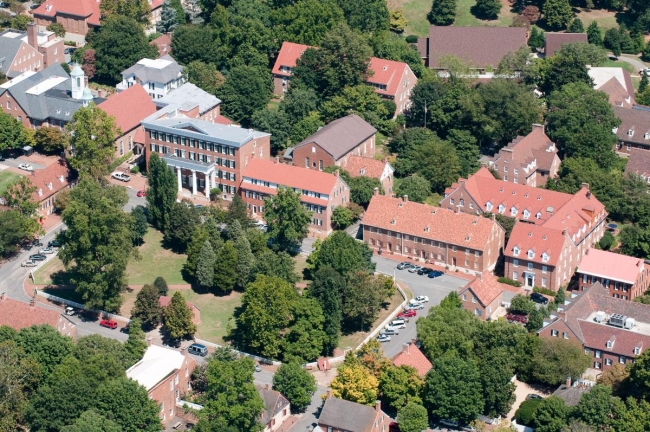You have /5 articles left.
Sign up for a free account or log in.

Salem College in North Carolina
Courtesy of Salem College
Women far outnumber men in American higher education. Recent data from the National Student Clearinghouse Research Center showed that more than 10 million women enrolled at a college or university last spring, compared with 6.8 million men.
Yet the number of institutions first created to educate women is dwindling. Today, there are fewer than 50 women’s colleges in the United States, down from 230 in 1960, according to the Women’s College Coalition.
Some of those 230 colleges have since opened their doors to men. Others have closed, in part due to enrollment challenges fueled by expanded educational access for women and decreasing demand for single-gender institutions. The remaining women’s colleges must offer a compelling response to the question: Why attend a college for women when the same programs are available at coed institutions?
For some women’s colleges, the answer is to find a niche.
Salem College in Winston-Salem, N.C., recently announced it will overhaul its curriculum to focus on health science and leadership -- an area of study college officials said is in demand among high school girls.
Undergraduate enrollment at Salem has slipped in recent years, falling from 999 students in 2015-16 to 591 students during the 2019-20 academic year, according to data from the National Center for Education Statistics. The health leadership focus could help the liberal arts college stand out from the pack.
“What’s really important for liberal arts colleges and for women’s colleges is to find your niche, to be distinctive, and to no longer be -- or try to be -- everything to everyone,” said Summer McGee, Salem’s new president. “It’s something that is on my mind every day -- how we are going to really give Salem women something that no other college and university in the country will give them, and that we will be able to be successful because we’re unique.”
Texas Woman’s University, a public university system based in Denton, Tex., has also worked to differentiate itself. The public three-university system is coed, but it primarily enrolls women. The student body is diverse, which helps the system maintain its enrollment. A third of Texas Woman’s students are Hispanic or Latino, 17 percent are Black or African American and 37 percent are white, NCES data show.
“We were created for a segment of the population that didn’t typically go to college,” said Carine Feyten, chancellor of the system and vice chair of the Women’s College Coalition Board of Directors. “For example, we have strong performance in programs for young adults who have aged out of foster care, because that’s a group of students that hasn’t typically gone to college. Same thing with first-generation college students.”
While it can be helpful, finding a niche doesn’t guarantee an institution's long-term success. Judson College, a tiny Baptist women’s college in rural Marion, Ala., closed in July after its enrollment plummeted.
Judson’s student head count had always been small -- the college typically enrolled between 300 and 400 students -- but recent years showed stark declines. Last spring, Judson enrolled 145 students. College officials expected that only 80 students would have returned this fall.
Fuller Higher Ed Solutions, a consulting firm for Christian colleges, described Judson as “nearly a unicorn” in its February report about the college’s financial outlook. In other words, the college already had a niche -- it enrolled Baptist women from Alabama who wished to attend college in a rural area. But that demographic was shrinking, the report said. Fewer and fewer students sought out single-gender institutions or religious colleges. Alabama is expected to see a precipitous decline in the number of white high school graduates -- a market Judson targeted -- through 2036.
All these factors created a tough market for Judson, said W. Mark Tew, former president of the college.
“It doesn’t matter how good of a widget you make when people stop buying widgets,” Tew said. “Regrettably, women’s education as a viable option for a young woman is just falling out of the breakfast table conversation.”
Judson’s rural setting also posed recruitment challenges. Marion is home to about 3,275 people, and its population is slowly declining. Students are typically drawn to colleges in cities or suburbs, Tew said.
“The pull is to the metropolitan campus -- or at least the suburban campus -- where there are just a multitude of extracurricular activities,” Tew said. “The notion of having to leave any rural campus and driving 30 or 40 miles to the nearest social life -- that’s just not what 18-year-olds do anymore.”
Mills College in Oakland, Calif., is also on the brink of closure. The women’s college is well-known for its admissions policy that welcomes nonbinary students and transgender women, making a name for itself as a liberal arts college for LGBTQ students. Still, it has struggled to grow its enrollment and balance its books, and Mills announced in March that it would no longer admit new students.
Feyten is not convinced that single-gender status is to blame for dwindling enrollments. Many other small private colleges share the enrollment challenges that Judson, Mills and others have faced.
“I wonder if we are focusing on the wrong variable,” Feyten said. “It could be because a lot of those women’s colleges are smaller, and smaller institutions are having more challenges these days.”
At least a handful of women’s colleges have grown in recent years. Wellesley College in Massachusetts, Bryn Mawr College in Pennsylvania and Barnard College in New York City all increased their enrollment between the 2014-15 and 2019-20 academic years, NCES data showed. Each enrolls between 1,450 and 3,000 students, and all three benefit from strong brand recognition, substantial endowments and strong donor bases.
“Bryn Mawr College has emerged from the past year in a strong position,” Kim Cassidy, president of Bryn Mawr, said in an email. “This past year, Bryn Mawr received a record number of applications for our incoming class, and more students than ever accepted our offer of admission. We are expecting the college’s largest and most academically talented class on record this fall.”
A number of women’s colleges saw an increase in applicants a few years ago when the Me Too movement was at its height. More and more high school girls wrote about women’s issues in their application essays as well, college officials said at the time.
Emerald Archer, executive director of the Women’s College Coalition, hopes that women’s colleges will continue to lean into their missions.
“I think recognizing the specific value add that a women’s institution brings is really important,” Archer said. “We are singularly focused on creating the next cadre of women leaders, and we have programs specific to making sure that women are raising their hand, and serving their community, and gearing up and creating space for more inclusive leadership.”








